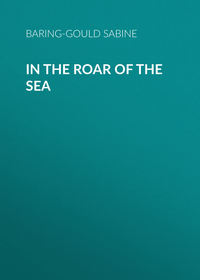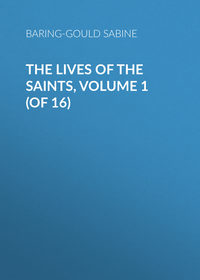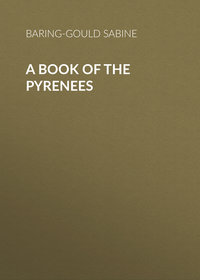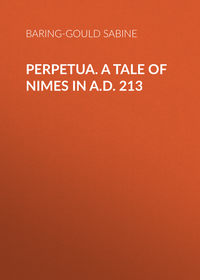 полная версия
полная версияA Book of North Wales
Llewelyn ab Iorwerth, surnamed “the Great,” was king of Gwynedd at the beginning of the thirteenth century, and he had sufficient wit to see that the only salvation for Wales was to be found in its reunion, and he attempted to achieve this. As Powys was obstructive, he had to fight Gwenwynwyn its king, then to subject Lleyn and Merioneth.
In 1202 Llewelyn was firmly established in Gwynedd, and he married Joan, the daughter of King John, who proceeded to reinstate Gwenwynwyn in Powys. In 1211 this prince sided with Llewelyn against John, who, furious at this act of ingratitude, hanged twenty-eight Welsh hostages at Nottingham.
Llewelyn now turned his attention to the conquest of South Wales. He stormed one castle after another, and obtained recognition as prince of Dynevor. But in 1216 the false and fickle Gwenwynwyn abandoned the Welsh side and went over to that of the English. After some fighting Llewelyn submitted to Henry III. at Worcester in 1218.
His grandson, another Llewelyn, was also an able man, but he lacked just that essential faculty of being able to detect the changes of the sky and the signs of the times, and that ruined him.
In 1256 Llewelyn was engaged in war against the English. He had done homage to Henry III. in 1247, but the unrest in England caused by the feeble rule and favouritism of Henry had resulted in the revolt of the barons. Llewelyn took advantage of this condition of affairs to recover Deganwy Castle and to subdue Ceredigion. Then he drove the unpatriotic son of Gwenwynwyn out of Powys. The same year he entered South Wales, and was everywhere victorious. Brecon was brought under his rule, and the castles held by the English were taken and burned. But Llewelyn’s great difficulty lay with his own people, though his power was used for the recovery of Wales from English domination.
In 1265 he had received the oaths of fealty throughout Wales, which was now once more an independent principality. But he made at this point a fatal mistake. He did not appreciate the strength and determination of Edward I., the son of the feeble Henry, and in place of making favourable terms with him he intrigued against him with some revolted barons.
But Edward was a man of different metal from his father, and he declared war against Llewelyn, and in 1277 invaded Wales.
Three formidable armies poured in, and Llewelyn was driven to take refuge among the wilds of Snowdon, where he was starved into submission. All might have gone smoothly thenceforth had Edward been just. But he was ungenerous and harsh. He suffered his officials to treat the Welsh with such brutality that their condition became intolerable. Appeals for redress that were made to him were contemptuously set aside, and the Welsh princes and people felt that it would be better to die with honour than to be treated as slaves.
A general revolt broke out. In 1282 Llewelyn took the castles of Flint, Rhuddlan, and Hawarden in the north, and Prince Gruffydd rose against the English in the south.
Edward I. resolved on completely and irretrievably crushing Wales under his heel. He entered it with a large army, and again drove Llewelyn into the fastnesses of Snowdon. Llewelyn thence moved south to join forces with the Welsh of Dyved, leaving his brother David to hold the king back in North Wales.
The place appointed for the junction was near Builth, in Brecknock, but he was betrayed into a trap and was surrounded and slain, and his head sent to Edward, who was at Conway.
Edward ordered that his gallant adversary’s body should be denied a Christian burial, and forwarded the head to London, where, crowned in mockery with ivy leaves, it was set in the pillory in Cheapside. Nor was that all: he succeeded in securing the person of David, had him tried for high treason, hanged, drawn, and quartered. Llewelyn’s daughter was forced to assume the veil. Thus ended the line of Cunedda, and Llewelyn is regarded as the last of the kings of Wales.
Edward was at Carnarvon when his second son Edward was born, 1301, and soon after he proclaimed him Prince of Wales.
It has been fondly supposed that this was a tactful and gracious act of the king to reconcile the Welsh to the English Crown. It was nothing of the kind. His object was to assure the Crown lands of Gwynedd to his son.
“Edward’s brutal treatment of the remains of Llewelyn, who, though a rebel according to the laws of the king’s nation, was slain in honourable war, and his utter want of magnanimity in dealing with David were long remembered among the Cymry, and helped to keep alive the hatred with which the Welsh-speaking people for several generations more regarded the English.”1
The principality of Wales indeed remained, but in a new and alien form, and all was over for ever with the royal Cymric line.
PEDIGREE OF THE PRINCES OF GWYNEDD AND OF POWYS
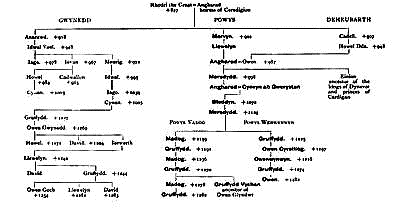
CHAPTER III
ANGLESEY
The “Mother of Wales” – Agricola – Invades Môn – Mines – Caswallon Long-hand – Drives out the Irish – Conquest by Edwin – Aberffraw – Characteristics of Anglesey – Plas Llanfair – Llandyssilio – Llansadwrn – Inscribed stone of Sadwrn – Prophecy – Beaumaris – Bulkeley monuments – Penmon – Church of S. Seiriol – Old gallows – Puffin Isle – Maelgwn Gwynedd – Gildas – Loss of the Rothesay Castle– Tin Sylwy – English and Welsh inscriptions – Monument of Iestyn – His story – The Three Leaps – Amlwch – Llaneilian – John Jones – Llanbadrig – The witches of Llanddona – Goronwy Owen – Lewis MorrisANGLESEY is called the “Mother of Wales,” apparently because of its fertility and as supplying the mountain districts of the Principality with corn.
It has not the rugged beauty of the greater portion of Wales – there is, however, some bold coast scenery on the north and the west – but it possesses one great charm, the magnificent prospects it affords of the Snowdon chain and group and of the heights of Lleyn. Its Welsh name is Môn, which was Latinised into Mona, and it did not acquire that of Anglesey till this was given to it by King Egbert in 828. We first hear of it in A.D. 78, when the Roman general Cn. Julius Agricola was sent into Britain. He at once marched against the Ordovices, who occupied Powys.
As represented by Tacitus, Agricola was a Roman of the purest type, a man sincere, faithful, and affectionate in his domestic relations, and gracious in his behaviour to all men. He was upright in his dealings, a fine soldier, an able general, but inflexible in his dealings with the enemies of Rome. The ancient Roman was filled with the conviction that the gods had predestined the City on the Seven Hills to rule all nations and languages, and that such as resisted were to be treated as the enemies of the gods. No mercy was to be accorded to them. Much of the same principle actuated the generals of the Republic and the Empire as did the followers of the Prophet. With one it was Rome, with the other Islam, or the sword.
The Ordovices had been most stubborn in their opposition, and most difficult to restrain within bounds. In a short but decisive campaign Agricola so severely chastised them that his biographer says that he almost literally exterminated them. This is certainly an exaggeration, but it implies the hewing to pieces of the chiefs and free men capable of bearing the sword who fell into his hands. Cæsar had treated the Cadurci, after their gallant stand at Uxellodunum, in the same way, and again the Veneti of Armorica, without a shadow of compunction. Whatsoever people opposed Rome was guilty of a capital crime, and must be dealt with accordingly. Agricola now pushed on to the Menai Straits, beyond which he could see the undulating land of Mona, the shore lined with Britons in paint, and brandishing their weapons, whilst behind them were ranged the Druids and bards inciting them to victory with their incantations and songs.
We can determine with some confidence the spot where Agricola stood contemplating the last stronghold of the Briton and its defenders. It was at Dinorwic, where now plies a ferry.
He waited till the strong current of the tide had run to exhaustion and left a long stretch of sand on the further side. The Britons seeing that he was without ships feared nothing.
But they were speedily convinced of their mistake. Agricola’s auxiliaries, probably natives of the low lands at the mouth of the Rhine, had no fear of the water, plunged in, and gallantly swam across the channel.
A massacre ensued; the island was subjugated, and Roman remains found on it in several places testify that the conquerors of the world planted troops there in camp to keep Mona in complete control. They worked the copper mines near Amlwch.
As the Roman power failed in Britain, Mona became the stronghold of the invading Gwyddyl or Irish; they held it, and erected on its commanding heights their stone-walled fortresses, and it was not till the time of Caswallon Long-hand, grandson of Cunedda, that they were dislodged. He fought them in a series of battles, drove them from their strong castles faced with immense slabs of granite, such as Tin Sylwy, swept them together into Holy Island, then broke in on their last remaining fortress. According to legend, Caswallon was obliged to fasten his Britons together with horse-hobbles, to constrain them to fight by taking away from them the chance of escape by running away. With his own hand he slew Serigi, the Irish chief, near the entrance to the camp, and those of the Gwyddyl who did not escape in their boats were put to the sword. By an odd freak much like ours in glorifying De Wet and Lucas Meyer, the Welsh agreed to consider their late enemy as a martyr, and a chapel was erected where he fell, and he is figured, very shock-headed and bearing the short sword wherewith he was killed, in a niche of the doorway of the church which now stands in the midst of the old Gwyddyl fortress.
Caswallon set up his residence on the hill above Llaneilian, where the foundations may still be traced – a spot whence in the declining day the mountains of Wicklow may be seen, the Isle of Man stands out to the north, and in clear weather Helvellyn may be distinguished on the rim of the blue sea.
Edwin, king of Northumbria, conquered both Mona and the Isle of Man in 625. The place of his landing is still pointed out at Lleiniog, near Beaumaris, and a mound of the Anglo-Saxon type remains to show where was his first camp. Here also Hugh the Fat, Earl of Chester, was killed by the arrow of Magnus Barefoot. But of this more presently. Driven from Deganwy, on the Conway, the kings of Gwynedd made their residence at Aberffraw, in Mona. Of that palace there are but scanty traces.
There is something remarkable in the character of Anglesey. The bold mountains of Wales come to an abrupt fall at the Menai Straits, and thence the island stretches west in low undulation rising nowhere to any considerable elevation, and scored across with depressions from north to south, feeble and imperfect replicas of the Menai Straits. One is the furrow occupied by the Malldraeth morass and sands, but this does not cut completely across the island. The other is more thorough; it severs Holy Island from the main body of Môn, but it is so narrow that it has been bridged at Penybont and the railway crosses it on a causeway at Valley.
Anglesey does not impress the visitor as being so fertile as has been supposed. There are long stretches of morass and moor strewn with pools. But perhaps Môn was first called the “Mother of Wales” because to it, as to a mother’s lap, retreated the Cymry when beaten, wounded, and sore before their oppressors. If so, it soon ceased to be their place of refuge, but formed a point d’appui for their enemies, whence to strike at them from the rear.
Mona, as already said, does not present us with very striking scenery, except on the coast, but it teems with interest in other ways. It is dotted with monuments of the primeval inhabitants – cromlechs and meini-hirion (the plural of maen-hir). It possesses very well preserved camps of the Gwyddyl invaders. It was first the sanctuary and school of the Druids, and after that, of their spiritual successors, the Saints. The slope of Mona towards the east is well timbered and studded with mansions, the park of Plas Newydd, the residence of the Marquess of Anglesey, Plas Llanfair, and the palace of the Bishop of Bangor. This prelate had his residence near the Cathedral, but this has been sold, and a lordly mansion has been given to him on the Straits, where he can turn his back on his Anglesey clergy, and say to the rest, “Between us and you there is a great gulf fixed.” The beautiful suspension bridge erected by Telford crosses the Straits at their sweetest spot. Here the channel is broken by a little island occupied by the graveyard and church of Llandyssilio. The church is of no architectural interest. It was founded by Tyssilio, one of the sons of Brochwel Ysgythrog, prince of Powys, when he ran away from Meifod to escape the blandishment of an over-affectionate sister-in-law.
Llansadwrn Church, beautifully situated and carefully restored, contains the tombstone of its patron saint. This is a small block, now broken, that was found under the wall of the north transept, and is now let into the side of the chancel. It bears the inscription: Hic Beatu(s) Saturninus Se(pultus I)acit. Et Sua Sa(ncta) Coniux. P(ax). The knight was an Armorican prince, and the brother of S. Illtyd, founder of Llantwit Major, in Glamorganshire. Sadwrn and his wife Canna, who was his cousin, left Armorica, owing probably to some family unpleasantness. After his death she married again, and became the mother of Elian the Pilgrim, of whom we shall have something to say presently. In the very interesting church of Beaumaris is a tomb the sides of which are decorated with delicately carved figures of Anglesey saints, and among these are two that may be taken to represent Sadwrn and his wife. He is shown in armour, his sword sheathed, and holding a pilgrim’s staff in his left hand, whilst giving a benediction with the right.
When the tubular bridge for the railway was built it was considered that a prophecy made by a Welsh bard had been fulfilled, wherein he spoke of rising from his bed in Mona, of breakfasting in Chester, of lunching in Ireland, and of returning to sup in Mona. But the required speed to Ireland has not yet been attained. Another meaning or interpretation has been put on the words of Robyn Ddu. He was living at Holyhead when he wrote the lines in question, and there were two boats by the quay, one from Chester and the other from Dublin, and he breakfasted with the captain at his table in the first boat, took his midday meal in the cabin of the second, and returned to his own quarters to sup and sleep.
Beaumaris is a sleepy little place, only waking to life when the bathing season sets in. The castle was erected by Edward I., and took its name from its situation on the Fair Marsh. It is not a particularly striking building, and is far gone in ruin.
The church, however, which is of the same period, and due to Edward I., is worth a visit. The side aisles contain five two-light Decorated windows. The chancel is Late Perpendicular, with a very poor east window containing some fragments of stained glass. The arcade of the church is Perpendicular. In the vestry are Bulkeley monuments, removed at the Dissolution from Penmon. From Beaumaris a delightful excursion may be made to Penmon, which was a great nursery of saints for Gwynedd. It would be hard to find anywhere a sweeter or sunnier spot. The hills fold around the little dell in which lies the church, shutting off the gales from north and east and west, and open only to the south to let in the sun.
Unhappily a marble quarry is close by, and is eating into one of the arms that is wrapped lovingly about the old site, and will in time eat its way through.
In the combe, among ancient walnut and chestnut trees and flowering elder, are some relics of the monastery and its Norman priory church. The foundation of the cloister may be traced. The church is cruciform, and is aisleless. The south transept contains rich Norman arcades, and the arch into this transept is of the same period and of equal richness. A square font in the nave, covered with interlaced and key work, is the base of an old Celtic cross. A Norman doorway on the south side gives admission to the nave. This has knotwork and a monster biting its tail in the tympanum. The chancel is three steps below the level of the nave. A fine cross is in the south transept, taken out of the ruins of the priory, where it had served as lintel to a mediæval window.
S. Seiriol, the founder, is represented in stained glass of the fifteenth century in a window of the south transept, and a bishop, probably S. Elian, in one of the north transept. Near the church is the holy well of the saint, gushing forth from under a rock, and filling what was once the priory fishpond. The well is now in request mainly by such as desire to know what is in store for them in their love affairs, by dropping in pins and forming wishes.
About a mile distant, on a height where the rock comes to the surface, are four holes – the sockets for a pair of gallows, as the Prior of Penmon had seigneurial rights, and could hang misdoers.
Just off the coast is Ynys Seiriol, or Puffin Island, with the tower and ruins of a church on it. Hither retreated the monks of the first Celtic monastery to die and to be buried, and the soil is dense with their bones. The rabbits turn them up when burrowing. Here, according to tradition, Maelgwn, king of Gwynedd, was buried in 547. He was son of Caswallon, who drove the Irish out of Anglesey. Maelgwn was a remarkable man, tall and noble of countenance, and a masterful prince. He incurred the wrath of the ecclesiastics because he had once been a monk and had thrown aside the cowl. He was not particularly scrupulous about the rights of sanctuary claimed by the saints, and he was imperious in requisitioning meals of them when hunting in their neighbourhood.
He was, however, large-hearted and liberal, and when Caw, a prince of Strathclyde, and his sons came helter-skelter into Gwynedd, flying from the Picts, he generously received them and gave them lands in Anglesey.
Somewhat later, Gildas the historian, one of the sons of Caw, when himself safe in Brittany, wrote his venomous letter on the Destruction of Britain, and thus indecently and ungratefully attacked Maelgwn, the protector of his family: —
“Thou island dragon, first in wickedness, exceeding others in power and in malice, liberal in giving, but more prompt in sin, strong in arms, but stronger in what destroys the soul, why dost thou wallow in such a black pool of crimes? Why dost thou lade thy neck with such loads of heavy crimes? Thy conversion once on a time brought as much joy as now thy accursed reversion to thy disgusting vomit, like a sick dog, has caused sorrow. Thy ears are not given to listen to sacred hymns, but to the bawling of a rascally crew howling out lies and frothing phlegm, bespattering everyone round about.”
Probably Maelgwn was not a good man, but the family of Gildas owed every yard of land it possessed to his munificence. By a word only does Gildas allude to their indebtedness to him; not an indication appears of loving pity – all is scurrilous abuse of the most insulting description. He was a sixth-century counterpart of Mr. Cutcliffe Hyne’s Captain Owen Kettle, a curious combination of narrow religiousness and foulmouthedness. No wonder that in Brittany his symbol is a snarling cur. And the meanness of the man is conspicuous throughout. So long as his own skin was safe from the lash it deserved, he gave no thought to his kinsmen living under the protection of Maelgwn and other princes against whom he inveighed – with what unpleasant consequences to them we shall see presently.
At Ruys, in the Morbihan, is a very beautiful marble statue of him, set up by his tomb a few years ago. It represents a young monk with angelic face, and a mouth in which butter would not melt. It is too funny for words to look at that idealised portrait and read the Destruction of Britain.
And now the bones of Maelgwn lie in Ynys Seiriol. In 1897 some excavations were made on the island by Mr. Harold Hughes, who says: —
“On removing the debris of centuries” – near the ruined church – “with the aid of pick and shovel we have succeeded in making a considerable clearing immediately to the east of the structure. We discovered at about four feet from the surface an ancient tomb. Beneath the rough clay, worn slabs, and covered with shingle from the shore, lay within a narrow inclosure, with feet to the east, the skeleton of a man. Although portions of the skeleton had crumbled away, many fragments remained, and these, after much difficulty, I pieced together.”
Was this, one may ask, the tomb of the famous Maelgwn Gwynedd?
From the island a reef runs into the sea, called the Causeway of Seiriol, and it is supposed that it was constructed by the saint as a means of communication with Penmaen Mawr. It disappears under the Dutchman’s Bank, a sandy stretch that obstructs the entrance to the Menai Straits. Hereon, in 1831, the Rothesay Castle was cast, when a hundred lives were lost. Miss Martineau, in her History of the Thirty Years’ Peace, tells a striking story of this wreck: —
“Two men, strangers to each other, found themselves holding on to the same plank, which, it soon appeared, would support only one. Each desired the other to hold on, the one because his companion was old, the other because his companion was young, and they quitted their grasp at the same moment. By extraordinary accidents both were saved, each without the knowledge of the other, and they met on the shore in great surprise. Few greetings in the course of human life can be so sweet and moving as must have been that of these two heroes.”
The country for some distance west of Penmon is commanded by Tin Sylwy or Bwrdd Arthur as it is also called. It rises 500 feet above the sea and is crowned by a fortification. The wall is of stone unset in mortar, faced within and without with slabs set on end, and within the area are faint traces of cytiau or circular huts of stone, such as are traditionally attributed to the Irish. Some excavations have been made here, but not on an extensive scale, and Roman coins and Samian ware have been found; but the extant walling assuredly belongs to the Gwyddyl invasion and occupation. Below the camp, between it and the church of Llanfihangel, is a holy well. In the graveyard may be noticed a token of a change of feeling towards the Welsh tongue. To the date 1860, or thereabouts, the inscriptions on the tombstones are in English, after that date in Welsh.
There is nothing in the church of Llaniestyn but the very curious carved slab with a full-length figure of the saint who founded the church. One very similar and of the same period, the reign of Edward III., is in Llanbabo Church. Iestyn was a son of Geraint, the heroic king of Devon and Cornwall, who fell at Langport, in Somersetshire, fighting against invaders, about the year 522. Iestyn was buried here. He seems to have travelled, and it is probably of him that a pretty story is told.
He had gone to Brittany, and had found a deserted habitation at Plestin, of which he took possession. The hut had been constructed by an Irish settler named Efflam, who had departed on a pilgrimage. On his return Efflam found his cell in the occupation of a stranger. The question arose as to which should have it. This they decided to determine in the following manner. Both seated themselves in the cabin. The day was overcast, but the clouds were breaking, and the sun was nearing its setting. He on whom it first shone should retain the hovel. Presently the clouds parted, and a golden ray shot in through the little window and blazed on Efflam’s upturned face. Then Iestyn rose, bowed, and withdrew, and ended his days in Mona. It is by an artist’s licence that on the monument Iestyn is represented wearing a crown. He was, indeed, a king’s son, but he never bore the royal circlet.
The somewhat similar monument is at Llanbabo, in the north-west of the island. Pabo, after long and stubborn fighting against the Picts in North Britain, was driven to take refuge in Wales, and was kindly received by the prince of Powys. He bears the title of “The Pillar of Britain.”


